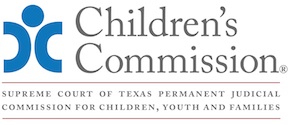7. Permanency Hearing After Final Order
15 minutes; up to 25 suggested best practice
Prior to Permanency Hearing (PH):
⧠ If parental rights terminated, first PH within 90 days of final order
⧠ If parent rights not terminated, first PH within 180 days of final order
⧠ 10 days’ notice of hearing
⧠ DFPS Permanency Progress Report filed 10 days before hearing; includes
• Child’s Permanency Plan
• Summary of Medical Care
⧠ The court file includes:
• Notification of consent for medical care
• Education Decision-Maker Form 2085E
At Hearing:
⧠ Identify those present
⧠ Child in attendance
⧠ If AAL has not seen client, form filed
⧠ Review Permanency Progress Report:
• Child’s safety and well-being
• Child’s needs (medical/special)
• Child’s placement
• If in institutional care, efforts to ensure least restrictive environment
• Primary/alternative permanency goals
• DFPS reasonable efforts to finalize the permanency plan:
o due diligence to place for adoption if rights terminated and child eligible; or
o APPLA, including appointing relative as PMC or returning the child to parent, appropriate for child
• For child with APPLA goal:
o desired permanency outcome; and
o whether APPLA best permanency plan; if so, compelling reasons why not in child’s best interest to:
▪ return home,
▪ be placed for adoption,
▪ be placed with legal guardian, or
▪ be placed with fit and willing relative
• If 14 or older, services to assist in transitioning from care to independent living in community
• Receiving appropriate medical care and provided opportunity to express opinion on medical care
• If receiving psychotropic medication:
o Provided appropriate nonpharmacological interventions, therapies, or strategies to meet needs; or
o seen by prescribing physician, physician assistant, or advanced practice nurse at least once every 90 days
• Education decision-maker and education needs and goals identified, major changes in school performance or serious disciplinary events
• For child in PMC without termination, whether DFPS to provide services to parent for up to 6 months after PH if:
o child not placed with relative or other individual, including foster parent, seeking PMC; and
o court determines further efforts at reunification with parent:
▪ in best interest of child; and
▪ likely to result in child’s safe return to parent
• DFPS identified family or other caring adult with permanent commitment to child
⧠ Address citizenship issues, consulate notified, SIJS
⧠ Ensure those present heard and provided opportunity to present evidence
⧠ Confer with child about permanency plan
⧠ Regular, ongoing opportunities to engage in age-appropriate normalcy activities
At End of Hearing:
⧠ Issue court order
⧠ Set next PH within 180 days
Best Practices:
⧠ If no notice, consider resetting hearing to secure attendance
⧠ Engage parties with direct questions
⧠ Engage youth
⧠ Ask DFPS direct, child-specific questions about both primary and concurrent goal
⧠ Next PH by 90 or 120 instead of 180 days
⧠ For youth who turn 18 while in care:
• Extended foster care and trial independence
• Referrals to Texas Workforce Commission
• Documents before leave care
⧠ Youth advised of eligibility for Family Group Decision-Making or Circles of Support about future
⧠ Youth enrolled in PAL or provided transitional services after 14th birthday
⧠ Ask the following questions:
• What is preventing this child from returning home today?
• How is my decision specific to this child and this family?
• Are there cultural issues we need to understand?
Well-being issues at Permanency Hearing:
Medical Care and Mental Health:
⧠ Summary of medical care:
• Nature of emergency medical care
• All medical and mental health treatment receiving and progress
• Any medication prescribed/progress
• Caregiver compliance with treatment plan
• Adverse reaction or side effects
• Diagnosis or diagnostic tests
• Activity to avoid that affect effectiveness of treatment
• Other info required
Education and Educational Decisions:
⧠ Enrolled in school/in appropriate grade
⧠ Remains in current school, if placement change
⧠ If placement change, determine:
• where child wants to attend school
• whether transportation available
• whether change coordinated with grading and testing periods
• whether records/credits transferred
⧠ If 0-3, child assessed for developmental milestones through ECI
⧠ If 0-5, child enrolled in Early Head Start, Head Start, or Pre-Kindergarten
⧠ Educational Decision-maker Form 2085E on file
⧠ School supports and disciplinary issues
⧠ Extracurricular activities/normalcy
⧠ Evaluated/receiving special ed services
⧠ If 14 or older, postsecondary edu plan
